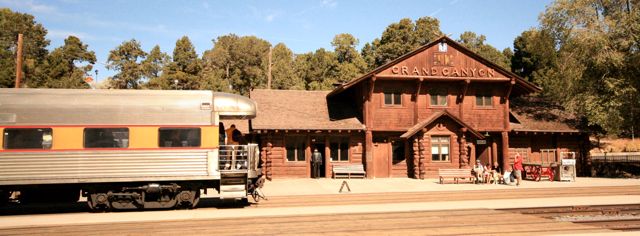
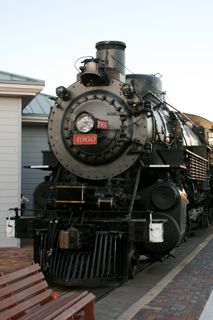 |
 |
 |
|
|
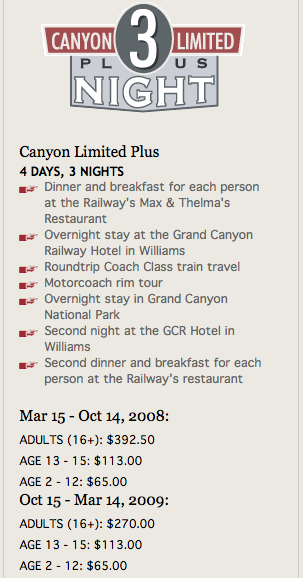 |
Getting There
|
Southwest
Chief
|
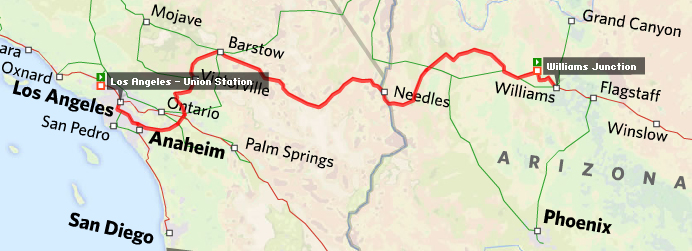
There are many classes of Service to choose from on the GCR. We chose First Class. Two considerations were air-conditioning, since it can still be hot in Arizona in October, and reclining seats and extra-large viewing windows. For Other Classes of Service, go to: www.thetrain.com/classes/ |
First ClassStyle and space - the opulence of oversized, reclining seats along with extra-large viewing windows, make for a true First Class experience. As do the fresh fruit, pastries, coffee and juice provided during the morning journey and champagne on the way back. Complimentary soft drinks are served throughout in these air-conditioned cars. Grand Canyon Railway has four first-class cars in its fleet. GCR's CollectionThe Coconino Car -  This unique dome coach was built by Budd Manufacturing Company in 1954 for the Chicago, Burlington and Quincy and Northern Pacific railways. It first served that railroad as No. 554. Amtrak purchased the car in 1971 and assigned it number 9481. Grand Canyon Railway purchased the car in 1996. It first went into service for Grand Canyon Railway in March 1997. This car features two classes of service: First Class and Deluxe Observation Class. Pastries, coffee, tea and fresh juice are available during the northbound journey. Champagne and appetizers on the southbound journey are included in the fare. Service from a fully stocked bar is also provided, and strolling musicians perform en route. Pepsi is complimentary. The Deluxe Observation area seats 24. It features panoramic views from a glass dome observation area. The section is configured to seat four across with a center aisle. Handicap service is not available and children under 11 are not allowed in this section. The First Class section seats 40 in comfortable recliner chairs. The section seats four across with a center aisle. Oversized restrooms with a sitting area are provided for both men and women. The Coconino Car is air-conditioned in the summer months and comfortably heated during the winter season. This car is staffed by a coach attendant, and it can be reserved for groups and special events. The Kokopelli Car -  Built for the Empire Builder, the premier "name train" between Chicago and Seattle, a train jointly operated by the Great Northern Railway, the Burlington and the Spokane, Portland & Seattle. The three railroads shared ownership of the car. The car was originally put into service for the GNRy, May 29, 1955 with the number 1326. On May 1, 1971 Amtrak took over the nation's remaining passenger routes. Car No. 1326 and her sister joined the new system. Owned by Amtrak until 1984. From 1984-1985 the car was leased to the Alaska Railroad, after that the car was stored for a number of years and finally sold to a private owner. In 1998, under the new ownership of the Great Northern Dome Co., the car underwent a full rebuild after years of neglect. The rebuild included a complete truck rebuild and installation of two Safety-Stone heating and air conditioning systems. In May of 2000, Grand Canyon Railway leased No. 1326 from the Great Northern Dome Company to replace another dome car in the GCRy consist. No. 1326 was repainted and named the Kokopelli. This car features two classes of service: First Class and Deluxe Observation Class. The Deluxe Observation area seats 24. It features panoramic views from a glass dome observation area. The section is configured to seat four across with a center aisle. Handicap service is not available and children under 11 are not allowed in this section. The First Class section seats 40 in comfortable recliner chairs. The section is configured to seat four across with a center aisle. Oversized restrooms with sitting areas are available for both men and women. The Kokopelli Car is air-conditioned in the summer months and comfortably heated during the winter season. This car is staffed by a coach attendant and it can be reserved for groups and special events. The Colorado River Car - This car was built in 1948 as a 16-section sleeper for the Denver Rio Grande Western. At the DRGW it was called Silver Aspen and given number 1120. It was eventually converted to a 48-seat coach and acquired by the Chicago Northwestern and renamed the Iowa River with number 422. The CNW put the Iowa River into its business-car fleet where it served as a classroom. The car changed hands a couple of times before being acquired by Railroading Heritage of Midwest America, a foundation dedicated to preserving historical railroad equipment. Grand Canyon Railway purchased the car in June of 1999 from Railroading Heritage of Midwest America. Grand Canyon Railway rebuilt the car and put it into service in April 2000. The car was renamed the Colorado River and given the number 2098 at that time. The Colorado River features First Class service. Pastries, coffee, tea and fresh juice are provided during the northbound journey. Champagne or sparkling cider and appetizers on the southbound journey are included in the fare. Service from a fully stocked cash bar is also provided. Strolling musicians perform during the journey to and from the canyon. Pepsi is complimentary. This First Class car seats 50 in comfortable reclining chairs that are configured for seating four across with a center aisle. This car is staffed by a coach attendant. Restrooms are available for men and women. The Colorado River is air-conditioned in the summer months and comfortably heated during the winter season. This car can be reserved for groups and special events. The Arizona and Bright Angel Cars These classic cars were part of a large 32-car order sent to the Budd Manufacturing Company in 1951 (Job 9621-110). The order of 60-seat coaches with lounges was part of an attempt by the Pennsylvania Railroad to upgrade service on the busy New York – Washington corridor. The Boston Washington Senator and the Morning and Afternoon Congressional trains received most of the cars, but several went to other trains. The cars ran with the Pennsylvania Railroad, beginning in 1952. Then later moved to Penn Central Railroad. In 1976, Amtrak purchased all but two of the original 32 cars. Many of the cars were still in service for Amtrak as late as 2001. Two of the original 32, No. 1568 and No. 1581, were scrapped in 1968. Grand Canyon Railway acquired the cars in 2003. It completed a full restoration and in 2004, the cars went into service as First Class coaches. Today, passengers can enjoy the original color combinations and etched glass and mirrors featuring historic early American themes. |
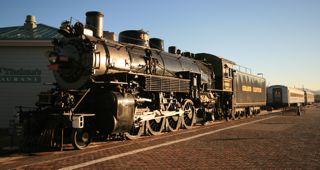 September 11, 2008WILLIAMS, Ariz. - Fires
have been permanently dropped
from Grand Canyon Railway's steam locomotives, owner Xanterra Parks
& Resorts has announced. The company said it is permanently
canceling the steam program owing to its impact on the environment, and
has laid off 20 employees as a result. An industry source with specific
knowledge of the situation, however, paints the action as a business
decision driven by fewer riders and costlier fuel.
September 11, 2008WILLIAMS, Ariz. - Fires
have been permanently dropped
from Grand Canyon Railway's steam locomotives, owner Xanterra Parks
& Resorts has announced. The company said it is permanently
canceling the steam program owing to its impact on the environment, and
has laid off 20 employees as a result. An industry source with specific
knowledge of the situation, however, paints the action as a business
decision driven by fewer riders and costlier fuel.